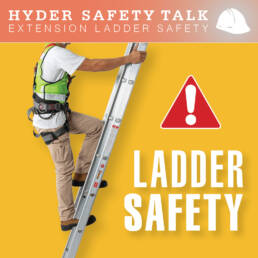
One of the most common tools we use on the jobsite is a ladder. Falls from heights are the leading cause of death at home and work. OSHA estimates that, for general industry companies, falls from ladders account for 20% of fatal and lost workday injuries every year. It is easy to assume everyone in construction knows and understands how to use ladders, but this is just a misconception. We have to realize many may not use ladders as part of their normal work task; therefore we have to make sure we are promoting safe ladder usage by training and prompting best practices daily.
By practicing the basics of ladder safety, serious accidents can be eliminated or substantially reduced. We must constantly plan our work (specifically at heights), discuss ladder best practices, and ensure all of our team members, including subcontractors, understand how to set up and use ladders correctly. Let’s review some of the rules and best practices for setting up an extension ladder.
- Ensure the feet of the ladder are placed correctly on the ground. Use the rubber side of the feet when on a smooth surface or flip feet up to expose the metal teeth when on dirt or in a grassy area.
- Never set a ladder on top of a stack of pallets, wood, or other object to gain more height; use a taller ladder instead. If you set up a ladder on such an unstable base, you’re just asking for an accident.
- Never lean a ladder against a surface that isn’t strong enough to support your weight, such as a window or an object that might move under your weight.
- Remember the 4-to-1 rule: Place the base of the ladder 1 foot from the wall for every 4 feet between the base and the support point. For example, if it is 8 feet from the base of a ladder to its support point, the base of the ladder should be 2 feet away from the building.
- Extend extension ladders at least 3 ft above a support point such as the edge of a roof. You should be able to step off the ladder and maintain 3 points of contact.
- Make sure that the upper section of an extension ladder overlaps and rests on the bottom section. The overlap should always be on the climbing side of the ladder. For ladders 36 feet or longer, the overlap should be least 3 feet.
- Always tie off ladders at the top and bottom to prevent shifting while climbing. If you cannot secure the ladder have a coworker hold the ladder for you to ensure it doesn’t move.